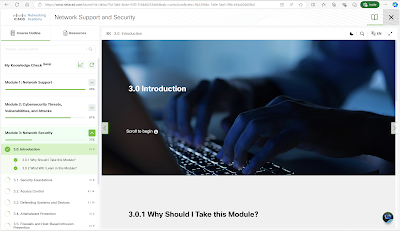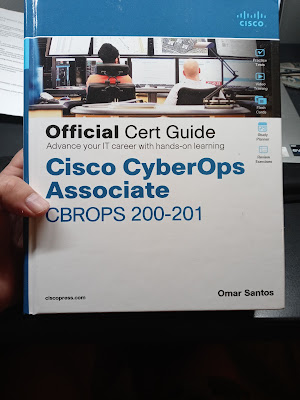Working My Way Through the CCNA Official Cert Guide
A couple of weeks ago, I went ahead and began studying for the Cisco Certified Network Administrator certification. This IT certification is better known by its abbreviation: CCNA. As I mentioned in a previous post on here on my blog, when I worked at the Social Security Administration (SSA) in Woodlawn, MD as a Tier 1 help desk agent, I made an attempt to study for the Network+ certification offered by CompTIA. Due to the sheer volume of information required to know for the certification, I gave up on studying for Network+. I then made an attempt at studying for the CCNA certification. I got as far as either Chapter 9: "Spanning Tree Protocol Concepts" or Chapter 10: "RSTP and EtherChannel Configuration" before stopping. I was having trouble understanding some of the topics in either chapter, so I got bogged down studying. In addition, I went through a period where I got REALLY BUSY with work. It's amazing how that works.
Over the past year, I have been taking online courses via Cisco's Networking Academy. Since I recently completed all four online classes for networking, it seemed like the perfect time to make another attempt to study for (and earn) the CCNA certification from Cisco.
A couple of months ago, I discovered on Cisco's own website that an updated and revised version of the Official Cert Guide for CCNA 200-301 would be published and available for sale in July 2024. Well, the first volume would be available. At the time, the second volume of the Official Cert Guide had been scheduled to be published a month or two after. Even though I was busy working on the online courses at the Cisco Networking Academy, I went ahead and bought the first volume of the new certification guide from Amazon as soon as it was available for purchase.
Since I decided to make another attempt to pass the CCNA certification exam, I quickly made it through Part 1: "Introduction to Networking". Part 1 consists of the following chapters:
- Chapter 1: Introduction to TCP/IP Networking
- Chapter 2: Fundamentals of Ethernet LANs
- Chapter 3: Fundamentals of WANs and IP Routing
To be honest, Part 1: "Introduction to Networking" was a good review of the information covered in the four online networking classes that I had completed.
I then began work on Part 2: "Implementing Ethernet LANs", which consists of the following chapters:
- Chapter 4: Using the Command-Line Interface
- Chapter 5: Analyzing Ethernet LAN Switching
- Chapter 6: Configuring Basic Switch Management
- Chapter 7: Configuring and Verifying Switch Interfaces
I then made short work reading chapters 4, 5, 6, and 7. Like the chapters in Part 1: "Introduction to Networking", chapters 4, 5, 6, and 7 were another good review. However, using the Cisco IOS to configure different aspects of a network switch is like riding a bike to a certain degree. Part of my plan for studying for the CCNA certification is to use Network Simulator software offered by Pearson Vue. The objective of the Network Simulator tool is to give you experience using Cisco IOS by giving you exercises to work on after reading the corresponding chapter in the Official CCNA Cert Guide. Just know that the Network Simulator tool doesn't have exercises for every chapter in the Official CCNA Cert Guide. It just depends on whether the chapter in the Official CCNA Cert Guide covers new commands for the Cisco IOS.
On the night of December 11, 2024, I completed the exercises in Pearson Vue's Network Simulator tool for Chapter 7: "Configuring and Verifying Interfaces". Surprisingly, there were only three exercises for the chapter.
Before moving on to Part 3: "Implementing VLANs and STP", there are some things that I probably should do first.
In no particular order, here are some things that I should do:
- Go back and complete the "Do I Know This Already?" quizzes for chapters 4, 5, 6, and 7. The questions are probably very similar to the questions on the official CCNA certification exam. As a result, the more practice I can get with these types of questions, the better.
- Go to Wendell Odom's Cert Skills blog and work my way through the exercises for chapters 4, 5, 6, and 7. These exercises are similar to the Cisco IOS exercises found on Pearson Vue's Network Simulator. The difference is that Wendell Odom doesn't prompt you or guide you through the exercise. Instead, he gives you the network setup and tells you the changes that need to be made. It's up to you to try to figure out what commands that you need to enter into the Cisco IOS command prompt to complete the exercise. Wendell Odom does give you the answers. The nice thing about the Cisco IOS exercises available on the Cert Skills blog is that the exercises are free. While the exercises were conceived with using just a pen and a piece of paper, you can complete the exercises using Cisco's Packet Tracer application, which is available for free.
 |
| Screenshot of Wendell Odom's Cert Skills blog. |
- Create my own User's Guide to the Cisco IOS. That means going through chapters 4, 5, 6, and 7 creating my own tables of all of the Cisco IOS commands. There are also step-by-step instructions on how to configure passwords, for example. Once complete, I can then print out all of the tables and step-by-step guides and then put them into a notebook. Then, it's just a matter of adding additional tables and step-by-step guides as I complete subsequent chapters in the Official CCNA Cert Guide.
 |
| Cisco IOS User Guide on Google Docs. |
- Go back through chapters 4, 5, 6, and 7 and write down notes for all of the key topics that MIGHT be on the certification exam. So far, I have written down notes for chapter 4. Since I have completed those four online networking classes from the Cisco Networking Academy, this is largely just another review.
- Create my own simple networks using Cisco Packet Tracer and then configure all of the devices. The nice thing about this option is that Cisco Packet Tracer is F-R-E-E to download and use. Here on my blog, I wrote a post about other options available, such as Cisco Modeling Labs or GNS3, if you don't want to use Cisco Packet Tracer.
 |
| Cisco Packet Tracer exercise. |












































